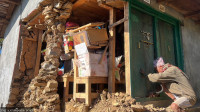Opinion
Decade of development
Can line ministries coordinate with each other to harness 10,000 MW in the next 10 years?
Saroj Dhakal
Earlier this year in February, Nepal’s Ministry of Energy moved forward with an action plan on National Energy Crisis Prevention and Electricity Development Decade, 2016 (NECPEDD 2016). This 92-step strategy passed by the Cabinet provides comprehensive steps to increase our electricity production to 10,000MW in the next decade. This document could be vital for the much awaited and needed reform in the energy market of Nepal to take the country into an era of prosperity and low carbon development. Likewise, the Energy Development Council (EDC), the umbrella association for Nepal’s energy sector, in partnership with a company from Shanghai, Neo Ventures, provided a new platform at the ‘Nepal Power Investment Summit 2016’ conducted from May 31 to June 3 in Kathmandu to spark a boom in the energy market.
Positive signs
The NECPEDD is envisioned to replace the Electricity Act, 1992 and the bill relating to National Electricity Regulatory Commission by more progressive acts. This will not only simplify the process of obtaining planning permits for electricity generation and clearing obstructions during the construction of power plants, but will also provide financial incentives to boost the confidence of investors and project developers. The plan has provisions for VAT refund and income tax exemption. There are policies in the pipeline to channel more investment from local banking and financing institutions into power projects.
This action plan comes at a time when Nepal and India have already inked the historic Power Trade Agreement (PTA), allowing exchange of electricity and opening up new vistas of cooperation in the hydropower sector. During the visit of Indian Prime Minister Narendra Modi to Nepal in August 2014, the two sides had agreed to sign an agreement allowing the exchange of electricity generated from hydel projects in Nepal. Meanwhile, during the recent visit of Prime Minister KP Sharma Oli to China, the two countries agreed to establish a Dialogue Mechanism on Energy Cooperation to facilitate long-term planning and cooperation in the energy sector, including trans-border power grids, hydro power and solar power, among others.
These are good signs for the energy market in the country. But now the Nepal government needs to pursue an active diplomacy and make investments in feasibility studies to determine the country’s capacity to produce energy if it is to position Nepal as the gateway of electricity trade between India and China in the long run.
The loopholes
If the NECPEDD 2016 is to be successful, it will require coordination among Ministry of Law, Justice and Parliamentary Affairs, Ministry of Energy—within which coordination among Department of Electricity Development, Water and Energy Commission and Nepal Electricity Authority is key—Investment Board of Nepal, Ministry of Land Reform and Management, Ministry of Home Affairs, Ministry of Finance, Nepal Rastra Bank, National Planning Commission, Ministry of Forest and Soil Conservation and Ministry of Population and Environment. This is where the problem lies.
Although Nepal is always ahead when it comes to designing policies and inking international agreements, implementation has largely been the problem. This is due to unstable internal politics, and lack of inter-ministerial coordination in coalition governments and cooperation from a politicised bureaucracy. Thus, whether coordination can be achieved to harness 10,000 MW in the next 10 years, which also requires an estimated 20 billion dollars, is perhaps the most important question for the Cabinet which endorsed the NECPEDD 2016.
Shifting the burden
If the government seeks efficient coordination between the line ministries, the 99-point action plan needs to highlight the role of the private sector to support the plan’s implementation. Given that coordination between ministries has always been poor in the country, a clearly defined role of the private sector to assist the government in achieving inter-ministerial coordination could help ensure smooth and efficient progress in terms of achieving the goals outlined in the NECPEDD 2016. Implementation would be easier if the institutional knowledge of various ministries and bureaucracy of Nepal, the main stakeholders of the NECPEDD 2016, could be utilised by engaging retired government officials and politicians.
A well-designed lobbying mechanism could provide the much needed push to move the files within the relevant ministries. Umbrella associations of the private sector such as the Confederation of Industries of Nepal [CNI], Federation of Nepali Chambers of Commerce and Industries [FNCCI], Independent Power Producers of Nepal [IPPAN], Brokers Association of Nepal and EDC need to cooperate to form a working committee to work for the implementation of the NECPEDD 2016.
With climate change as an emerging danger to humankind, there is a need for green and sustainable development in Nepal. It is imperative for us to harness the immense water, wind, solar, biogas and bio-fuel potential of this country. Thus, another option the government bodies should consider to execute the NECPEDD 2016 smoothly is authorise the beginning of a ‘Green Stock Exchange’ regulated by Securities Board of Nepal. Renewable energy companies, which would be interested to list themselves on the basis of free floating share, could join the stock exchange. Other energy intensive companies featuring core industrial sector of Nepal, which shift to clean energy or compensate for their emission, could be listed as well. The framework for energy projects and index can be designed as per the status of the project so that financing is possible at any point during the project. The stock exchange would facilitate small and large investments, stocks packaging, risk analysis, currency hedging, financial product sales and if possible trade of financial products within international markets, while providing an easy exit strategy for the investors. Such market mechanisms to address climate change could draw in huge financial support from other countries. The NECPEDD 2016 should be aimed to create a vibrant green market within Nepal by utilising the financial ingenuity of market-makers and opening connectivity of the Nepali financial market with international markets.
Dhakal is the CEO of 8848Inc'




 12.12°C Kathmandu
12.12°C Kathmandu










